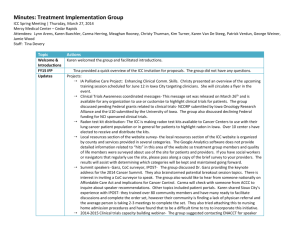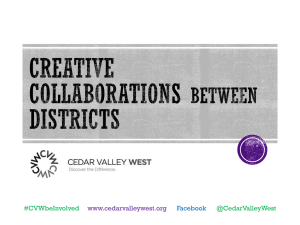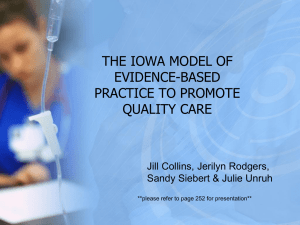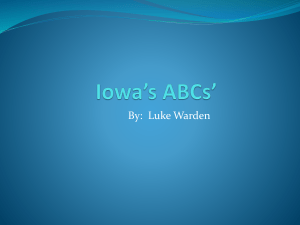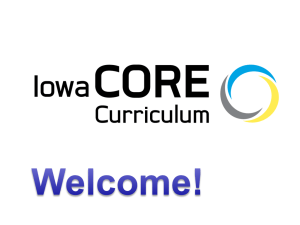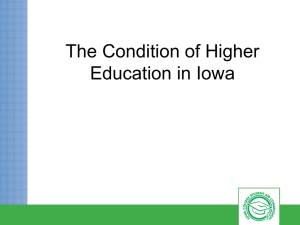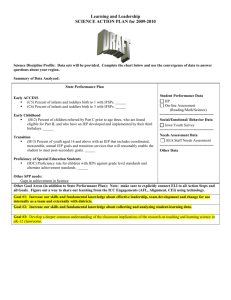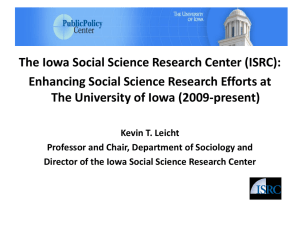Classroom Expectations
advertisement
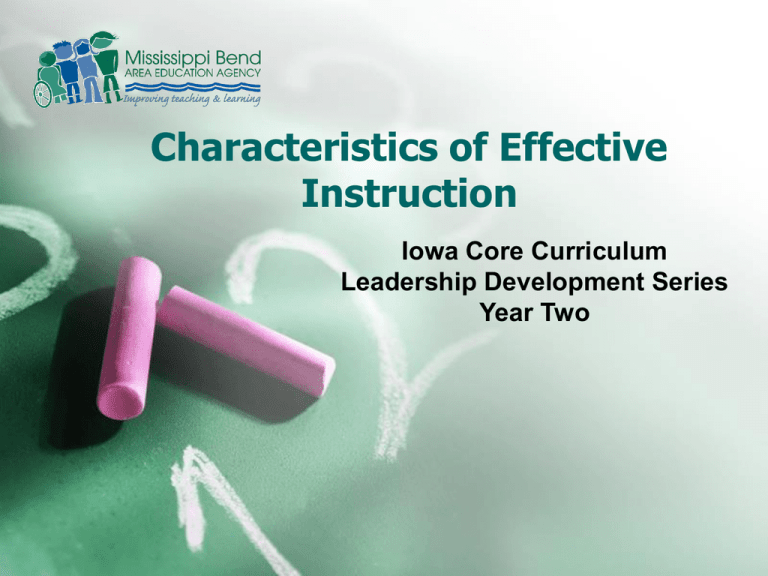
Characteristics of Effective Instruction Iowa Core Curriculum Leadership Development Series Year Two Welcome Back! Year Two: Objectives • To deepen understanding of Iowa Core Curriculum • To increase foundational knowledge of Alignment, Instruction, and Assessment in order to determine future direction of district • To obtain materials and information for replication back in district and to support initiative and district (10%-10% -80%) • To complete Self-Study for baseline data to create draft version of Implementation Plan Tough Questions for Journey Ahead 1. Can we change and make improvements in education? Will we? 2. What does it look like in the classroom? 3. HOW are we going to go about it? 4. What can be done that will get us there? LUNCH 11:40 am– 12:50 pm We will start on time! Motivation When I Become a Teacher . . . “Roll-Out” Document Year Two: Stages of Work for Districts Stage 1: Initial Awareness of Iowa Core Curriculum Stage 2: Introductory Work in Content, Instruction, and Assessment AND Making Connections Stage 3: Digging Deeper with the Iowa Core Curriculum Stage 4: Making Iowa Core Curriculum a Reality Stage 5: Full-Implementation & Continuous Improvement Charting Progress Stage Stage 1: Attributes Attributes of Stage 1 Initial Awareness of Iowa o Core Curriculum Participants are . . . . Aware of the basic structural design of the Iowa Core Curriculum (ICC) Able to articulate intents & purposes of ICC Understands the implications of ICC in the classroom Documentation: 1. Initial rating from Self-Study obtained or reviewed (6 Outcomes) Time Frame August 2008 – December 2010 Training Focus Introduction to ICC and it’s Magnitude for Change 1st and 2nd Order Change Overview of Five Characteristics of Effective Instruction Local, State, National, & Global rationale for ICC Creation of ICC Vision (district) Introduction to Implementation Plan & SelfStudy Rubrics Round One, District Self-Study Activity Option 1: Participants attend initial six modules, “Leadership Development Series (LDS).”* Option 2: Training provided by district staff. Activity #1: AEA Roll-Out DISCUSS How does this document “fit” with what you have done? What will you need to do? What needs clarified? How will you know you’ve made progress? Making Connections to Iowa Core Curriculum SINA/DINA Connection Audit Process • Content, Instruction, and Assessment addressed • Element: Standards, item 3 • Element: Materials, item 2 • Element: Instruction, item 4 • Element: Assessment, item 3 • Professional Development: use of IPDM • Plus more . . . . . . . Action Plan Actions and Activities can and should address the Iowa Core Curriculum! Specifically HOW you assure it happens for each and every student. Professional Learning Communities or Data Teams • SCHOOLS engaged in collecting, sharing, reviewing, and analyzing data for direction of work Professional Learning Communities or Data Teams (cont.) • Committed LEADERSHIP actions “The challenge of change leadership is to create a “system” for continuous improvement of teachers/ lesson and supervision – rooted in a common vision of performance standards students must meet [ICC].” • COLLABORATION! “Teachers working alone, with little or no feedback on the quality of their lessons, will not be able to improve significantly- no matter how much professional development they receive.” » Tony Wagner, 9/17/9 Building Initiative Example: 6 + 1 Trait Writing Primary & Intermediate Writing Essential Concept with Skill: Use an effective writing process (prewrite, draft, revise, edit, publish) Evaluation of: Ideas, Organization, Voice, Word Choice, Sentence Fluency, Conventions The need to review, reflect, and discuss introduces students to the concept of being critics. Students are used to being the ones whose work is reviewed and corrected. Reviewing work is a complex task; students must analyze a piece of writing, evaluate it’s strengths and weaknesses, then predict how it would be different if changes were made. Activity #2: Making Connections • Groups of 2-4 • Choose a prevalent initiative in your district or building • Make the connection with Iowa Core Curriculum • Discuss as table group • 20 minutes Review of Five Characteristics of Effective Instruction Activity #3: Five Characteristics Review Think-Pair-Share Working with Examples Establishing a Definition Think-Pair-Share Review Characteristics of Effective Instruction 1. Teaching for Understanding (Review-Module 2, Read Article, “Teaching for Understanding,” by David Perkins and completed 4-box Frayer Model with small group) Teaching for Understanding T-P-S Characteristics of Effective Instruction 5. Teaching for Learner Differences (Module 5) T-P-S Characteristics of Effective Instruction 4. Student-Centered Classrooms (Module 5) Student-Centered Classrooms T-P-S Characteristics of Effective Instruction 3. Rigor & Relevance (Module 4, Matrix of what it is and is not) Rigor & Relevance T-P-S Characteristics of Effective Instruction 2. Assessment for Learning (Module 3, Read Article, “Fair Test,” and looked at different vignettes of what is and is not formative assessment) Activity Directions Step 1 Number off 1-5 Step 2 Read definition of the characteristic of effective instruction (found on blue sheet). Step 3 Read through the cards and place under the appropriate column on your poster Activity Directions (cont.) Step 4 Rotate clockwise when you hear signal If you think one of the cards is incorrect, place a * on the poster and write which poster you believe where the card would be better placed. Repeat rotation Step 5 Return to your original chart Group decides final placement of cards Activity Directions (cont.) Step 6 Write a group summary: Teaching for Understanding means to us __________. (Replace underlined phrase with the effective instruction you began and ended with) BREAK (10 minutes) Differentiated Instruction Linda Mannhardt Chuck Solheim Nicole Peterson LUNCH 11:40 am– 12:50 pm We will start on time! IOWA CORE CURRICULUM: LESSON SAMPLE The Grant Proposal Project • Sarah Brown Wessling, Johnston, Iowa • English Teacher • Assignment: Students create a nonprofit organization, currently unavailable in central Iowa, that will support a verified need in the community; they will fund this organization by asking for fictitious grant monies from a grant panel. Activity #4: During Video & Discussion Questions • View Video Segment • Step One: Individually apply Information to Five Characteristics Sheet & complete during video Can you identify five characteristics? • Step Two: Following video, In a group of 2-4, choose at least two discussion questions and discuss. • Share out • 25 minutes Effective Instruction Briefs Review Guiding Questions and Review These Important Questions 1. Can we change and make improvements in education? Will we? 2. What does it look like in the classroom? 3. HOW are we going to go about it? 4. What can be done that will get us there? PROCESSING & EVALUATION


